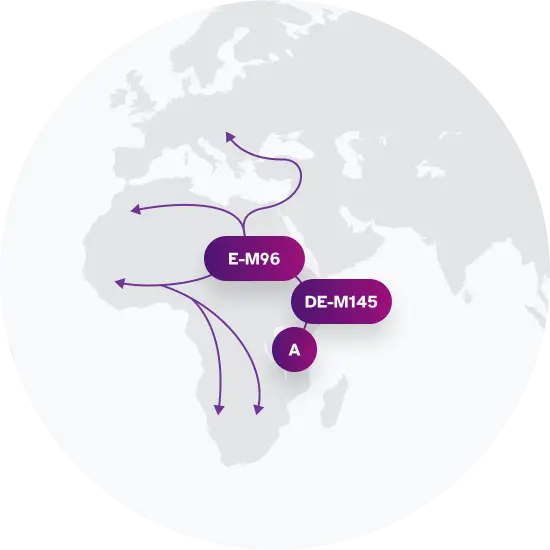Haplogroup E-M5021
What is Paternal Haplogroup E-M5021?
Haplogroup E-M5021, also known as Haplogroup E-M96 (Y Chromosome Consortium long-form label), is a genealogical group of lineages defined by unique genetic markers present on the Y-chromosome. Your paternal haplogroup, or that of your father if you do not have a Y-chromosome, paints a picture of your ancient origins and the migrations of your ancestors. Although your paternal haplogroup reflects just one of your many ancestral lineages, it carries information about that lineage over tens of thousands of years.
Haplogroup E-M5021 is descended from haplogroup E-M96. Among 23andMe research participants, haplogroup E-M5021 is commonly found among populations in the United Kingdom and Ireland.
It's important to note that your haplogroup doesn't define your current ethnic identity; rather, it provides an insight into your deep ancestry on the paternal side.
 Paternal Haplogroup Origins E-M96
Paternal Haplogroup Origins E-M96Top Surnames with Haplogroup E-M5021
For surnames with sufficient representation in the data, these percentages represent the frequency with which each surname is found in individuals exhibiting this genetic marker.
Haplogroup E-M5021 is linked to early European farmers
If you have haplogroup E1b1b1, your paternal line stems from a branch of E-M215 called E-M5021. Men bearing this lineage migrated from the Balkans to southwestern Europe during the spread of agriculture by early farmers in the agricultural revolution, which began about 10,000 years ago in the Fertile Crescent. Early members of haplogroup E1b1b1, some of the world's first farmers, had a competitive advantage over native men, who didn't have farming technology. As a result of this advantage, haplogroup E1b1b1 became widespread and populous during the agricultural revolution. The effects of this ancient advantage are still seen today, with haplogroup E1b1b1 being represented from Portugal and Spain to Palestine, southern Africa, and Russia.
 The spread of agriculture transformed the way of life in Europe.
The spread of agriculture transformed the way of life in Europe.